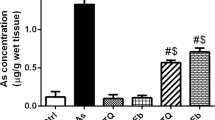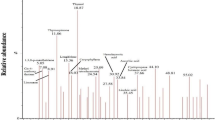Abstract
Present study demonstrates the therapeutic role of Emblica officinalis (EO) against arsenic-induced DNA and hepatic damage in female rats. Our earlier study on arsenic-exposed human unveils a link between tissue necrosis and carcinogenesis with impaired antioxidant system-associated DNA damage. Here we show ingestion of EO extract (500 mg in 0.1 mL water) in combination with sodium arsenite (0.4 ppm)/100 g b.w. for 24 days to rats offered significant protection against arsenic-induced oxidative damages of DNA and hepatic tissue architecture. Arsenic only exposure decreased hepatic superoxide dismutase, catalase activities and the level of non protein soluble thiol with a concomitant increase in thiobarbituric acid reactive substances and conjugated di-enes which are restrained by EO with a restoration of antioxidant components. In conclusion, restricted generation of free radicals is correlated to DNA protection resulting in prevention of tissue necrosis and possible carcinogenesis.
Similar content being viewed by others
References
Roy, P. & Saha, A. Metabolism and toxicity of arsenic: A human carcinogen. Curr Sci 82:38–45 (2002).
Rahman, M. M., Nag, J. C. & Naidu, R. Chronic exposure of arsenic via drinking water and its adverse health impacts on humans. Environ Geochem Health 31Suppl 1:189–200 (2009).
Pott, W. A., Benjamin, S. A. & Yang, R. S. Pharmacokinetics, metabolism, and carcinogenicity of arsenic. Rev Environ Contam Toxicol 169:165–214 (2001).
Maiti, S. et al. Antioxidant and metabolic impairment result in DNA damage in arsenic-exposed individuals with severe dermatological manifestations in Eastern India. Environ Toxicol (2010) [Epub ahead of print] PubMed PMID: 20925122
Maiti, S. & Chatterjee, A. K. Effects on levels of glutathione and some related enzymes in tissues after an acute arsenic exposure in rats and their relationship to dietary protein deficiency. Arch Toxicol 75:531–537 (2001).
Yamanaka, K. et al. Induction of DNA damage by dimethylarsine, a metabolite of inorganic arsenics, is for the major part likely due to its peroxyl radical. Biochem Res Commun 168:58–64 (1990).
Inns, R. H., Rice, P., Bright, J. E. & Marrs, T. C. Evaluation of the efficacy of dimercapto chelating agents for the treatment of systemic organic arsenic poisoning in rabbits. Hum Exp Toxicol 9:215–220 (1990).
Chattopadhyay, S., Ghosh, S., Debnath, J. & Ghosh, D. Protection of sodium arsenite-induced ovarian toxicity by coadministration of L-ascorbate (vitamin C) in mature wistar strain rat. Arch Environ Contam Toxicol 41:83–89 (2001).
Mahata, J. et al. Effect of selenium and vitamin e supplementation on plasma protein carbonyl levels in patients with arsenic-related skin lesions. Nutr Cancer 60:55–60 (2008).
Chattopadhyay, S. & Ghosh, D. The involvement of hypophyseal-gonadal and hypophyseal-adrenal axes in arsenic-mediated ovarian and uterine toxicity: modulation by hCG. J Biochem Mol Toxicol 24:29–41 (2010).
Chattopadhyay, S. et al. Protective role of Moringa oleifera (Sajina) seed on arsenic-induced hepatocellular degeneration in female albino rats. Biol Trace Elem Res 142:200–212 (2011).
Ghosh, D. et al. Quercetin in vesicular delivery systems: evaluation in combating arsenic-induced acute liver toxicity associated gene expression in rat model. Chem Biol Interact 186:61–71 (2010).
Mishra, D. et al. Co-administration of monoisoamyl dimercaptosuccinic acid and Moringa oleifera seed powder protects arsenic-induced oxidative stress and metal distribution in mice. Toxicol Mech Methods 19:169–182 (2009).
Talwar, G. P. et al. A novel polyherbal microbicide with inhibitory effect on bacterial, fungal and viral genital pathogens. Int J Antimicrob Agents 32:180–185 (2008).
Ngamkitidechakul, C., Jaijoy, K. & Hansakul, P. Anti-tumour effects of Phyllanthus emblica L.: induction of cancer cell apoptosis and inhibition of in vivo tumour promotion and in vitro invasion of human cancer cells. Phytother Res 24:1405–1413 (2010).
Yokozawa, T. et al. Amla (Emblica officinalis Gaertn.) prevents dyslipidaemia and oxidative stress in the ageing process. Br J Nutr 97:1187–1195 (2007).
Sharma, A., Sharma, M. K. & Kumar, M. Modulatory role of Emblica officinalis fruit extract against arsenic induced oxidative stress in Swiss albino mice. Chem Biol Interact 180:20–30 (2009).
Bergmeyer, H. U., Hørder, M. & Rej, R. International Federation of Clinical Chemistry (IFCC) Scientific Committee, Analytical Section: approved recommendation (1985) on IFCC methods for the measurement of catalytic concentration of enzymes. Part 2. IFCC method for aspartate aminotransferase (L-aspartate: 2-oxoglutarate aminotransferase, EC 2.6.1.1). J Clin Chem Clin Biochem 24:497–510 (1986).
Schumann, G. et al. International Federation of Clinical Chemistry and Laboratory Medicine. IFCC primary reference procedures for the measurement of catalytic activity concentrations of enzymes at 37 degrees C. International Federation of Clinical Chemistry and Laboratory Medicine. Part 4. Reference procedure for the measurement of catalytic concentration of alanine aminotransferase. Clin Chem Lab Med 40:718–724 (2002).
Copeland, W. H., Nealon, D. A. & Rej, R. Effects of temperature on measurement of alkaline phosphatase activity. Clin Chem 31:185–190 (1985).
Gornall, A. G. et al. Determination of serum proteins by means of the biuret reaction. J Biol Chem 177:751–766 (1949).
Fawcett, J. K. & Scott, J. E. A rapid and precise method for the determination of urea. J Clin Pathol 13:156–159 (1960).
Bowers, L. D. Kinetic serum creatinine assays I. The role of various factors in determining specificity. Clin Chem 26:551–554 (1980)
Allain, C. C., Poon, L. S., Chan, C. S., Richmond, W. & Fu, P. C. Enzymatic determination of total serum cholesterol. Clin Chem 20:470–475 (1974).
Werner, M., Gabrielson, D. G. & Eastman, J. Ultramicro determination of serum triglycerides by bioluminescent assay. Clin Chem 27:268–271 (1981).
Buege, J. A. & Aust, S. D. Microsomal lipid peroxidation. Methods Enzymol 52:302–310 (1978).
Maiti, S. & Chatterjee, A. K. Differential response of cellular antioxidant mechanism of liver and kidney to arsenic exposure and its relation to dietary protein deficiency. Environ Toxicol Pharmacol 8:227–235 (2000).
Slater, T. F. Overview of methods used for detecting lipid peroxidation. Methods Enzymol 105:283–293 (1984).
Paoletti, F. & Mocali, A. Determination of superoxide dismutase activity by purely chemical system based on NAD(P)H oxidation. Methods Enzymol 186:209–220 (1990).
Sinha, A. K. Colorimetric assay of catalase. Anal Biochem 47:389–394 (1972).
Forman, H. J. Critical methods in Free Radical Biology & Medicine. Free Radic Biol Med 47 Suppl 2:S207 (2009).
Garcia-Martinez, V. et al. Internucleosomal DNA fragmentation and programmed cell death (apoptosis) in the interdigital tissue of the embryonic chick leg bud. J Cell Sci 106:201–208 (1993).
Schmitt, C. J. & Dethloff, G. M. Biomonitoring of Environmental Status and Trends (BEST) Program: Selected Methods for Monitoring Chemical Contaminants and their Effects in Aquatic Ecosystems. Information and Technology Report USGS/BRD/ITR (2000–2005).
Liu, K. T. et al. Adverse effects of combined arsenic and fluoride on liver and kidney in rats. Fluoride 32:243–247 (1999).
Karimov, Kh.Ia., Inoiatova, F.Kh. & Inoiatov, F.Sh. Toxic effects of various water pollutants on structural and functional parameters of hepatocytes. Vopr Med Khim 48:174–179 (2002).
Palaniappan, P. R. & Vijayasundaram, V. FTIR study of arsenic induced biochemical changes on the liver tissues of fresh water fingerlings Labeo rohita. Rom J Biophys 18:135–144 (2008).
World Health Organization. Environmental Health Criteria 18: Arsenic. Geneva: WHO International Programme on Chemical Safety; 1981.
Chen, C. J., Chiou, H. Y., Chiang, M. H., Lin, L. J. & Tai, T. Y. Dose-response relationship between ischemic heart disease mortality and long-term arsenic exposure. Arterioscler. Thromb Vasc Biol 16:504–510 (1996).
Li, M., Cai, J. F. & Chiu, J. F. Arsenic induces oxidative stress and activates stress gene expressions in cultured lung epithelial cells. J Cell Biochem 87:29–38 (2002).
Dhir, H., Agarwal, K., Sharma, A. & Talukder, G. Modifying role of Phyllanthus emblica and ascorbic acid against nickel clastogenicity in mice. Cancer Lett 59:9–18 (1991).
Poltanov, E. A. et al. Chemical and antioxidant evaluation of Indian gooseberry (Emblica officinalis Gaertn., syn. Phyllanthus emblica L.) supplements. Phytother Res 23:1309–1315 (2009).
Sumitra, M., Manikandan, P., Gayathri, V. S., Mahendran, P. & Suguna, L. Emblica officinalis exerts wound healing action through up-regulation of collagen and extracellular signal-regulated kinases (ERK1/2). Wound Repair Regen 17:99–107 (2009).
Naik, G. H. et al. In vitro antioxidant studies and free radical reactions of triphala, an ayurvedic formulation and its constituents. Phytother Res 19:582–586 (2005).
Sultana, S., Ahmad, S., Khan, N. & Jahangir, T. Effect of Emblica officinalis (Gaertn) on CCl4 induced hepatic toxicity and DNA synthesis in Wistar rats. Indian J Exp Biol 43:430–436 (2005).
Pandey, G. & Pandey, S. P. Phytochemical and toxicity study of E. Officinalis (amla). Int Res J Pharm 2:270–272 (2011).
Author information
Authors and Affiliations
Corresponding author
Rights and permissions
About this article
Cite this article
Maiti, S., Chattopadhyay, S., Acharyya, N. et al. Emblica officinalis (amla) ameliorates arsenic-induced liver damage via DNA protection by antioxidant systems. Mol. Cell. Toxicol. 10, 75–82 (2014). https://doi.org/10.1007/s13273-014-0009-8
Received:
Accepted:
Published:
Issue Date:
DOI: https://doi.org/10.1007/s13273-014-0009-8




